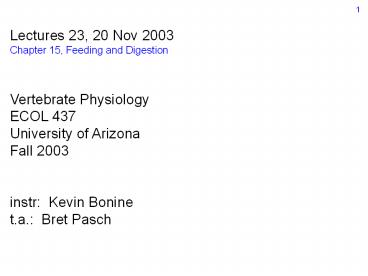Lectures 23, 20 Nov 2003 - PowerPoint PPT Presentation
Title:
Lectures 23, 20 Nov 2003
Description:
1 Lectures 23, 20 Nov 2003 Chapter 15, Feeding and Digestion Vertebrate Physiology ECOL 437 University of Arizona Fall 2003 instr: Kevin Bonine t.a.: Bret Pasch – PowerPoint PPT presentation
Number of Views:124
Avg rating:3.0/5.0
Title: Lectures 23, 20 Nov 2003
1
1
Lectures 23, 20 Nov 2003 Chapter 15, Feeding and
Digestion Vertebrate Physiology ECOL
437 University of Arizona Fall 2003 instr
Kevin Bonine t.a. Bret Pasch
2
2
Vertebrate Physiology 437
1. Feeding and Digestion (CH15) 2.
Announcements -Exams returned next week
-Powerpoint preview -Eldon Braun Thanks
3
3
FEEDING
4
4
Feeding
Filter Feeding -baleen whales -flamingoes
-planktivorous fish with modified gill rakers
-amphibian larvae
Fluid Feeding -lampreys -vampire bats
(analgesic and anticoagulants)
(15-3)
5
5
Seizing with mouth etc.
-Jaws, teeth, beaks -Form and function matched
Eryx tataricus
Modification for diet
(15-7)
6
6
Seizing with mouth etc.
Modification for diet
(15-8)
-Form and function matched -Darwins Finches in
Galapagos
7
7
Eunectes murinus
Seizing with mouth etc.
Most toothed non-mammalian vertebrates have
homodont dentition -Exception Some snakes
(15-6)
Some snakes also with venom - hemolytic,
neurotoxic
Viperidae, including rattlesnakes
8
8
Front Fanged Hypodermic Duvernoys/Venom Gland
Heloderma
Proteroglyph
Elapidae
Solenoglyph
Viperidae
Pough et al. 2001
9
9
Joe Slowinski Myanmar, Burma Bungarus
multicinctus Multibanded Krait alpha
bungarotoxin nicotinic ACh receptor antagonist
10
10
Alethinophidia, Macrostomata, Caenophidia,
Colubroidea Elapidae (62 genera, 300 species)
Naja spp.
- Cobras, coral, and sea snakes - venomous -
proteroglyph dentition maxilla longer than that
of vipers may have teeth posterior to
fang relatively fixed - some with biparental
care - most terrestrial are oviparous - most
marine are viviparous - corals often mimicked by
non-venomous sympatrics
Micruroides euryxanthus
11
11
Pit Organs multiple origins - vipers, boas,
pythons infrared image
(pit sensitivity to 0.003 C)
Pough et al. 2001
12
12
Gastric Brooding Frog Etc.
Python regius
Rheobatrachus vitellinus
13
13
Unidirectional Suction Feeding
Pough et al. 2001
14
14
Suction Feeding
Cryptobranchus alleganiensis
Salamanders
1. Jaws open 2. Hyoid apparatus (floor of
mouth) drops 3. Muscles keep gills closed
A few genera asymmetrical - flexible mandible
(cartilage)
Figure 9-5 Pough et al. 2001
15
15
Suction Feeding
Anurans
buccal
pharyngeal
Tadpoles unidirectional spiracle(s) filter
feeders - strain - mucus
atrial
branchial filters
Figure 9-6f Pough et al. 2001
Stebbins and Cohen, 1995
16
16
Turtle Suction Feeding
Bidirectional, no teeth (keratinous beak)
1. Compensatory suction - displaced water
2. Inertial suction - modified hyobranchial
- greater expansion
Figure 9-13 Pough et al. 2001
Esophogeal modifications - prevent prey escape
- Dermochelys, 5 cm spines
17
17
Feeding
Chamaeleo jacksonii
18
18
Hydromantes
Projectile Feeding
Deban et al. 1997
Salamanders
a
d
c
protractor
b
retractor
19
19
Snake Feeding
Scolecophidians
Ancestral Group
Leptotyphlops (teeth lower only)
- small gape
Mandibular raking
- short jaws
- many small prey
Fig. 4-25 Pough et al. 2001
20
20
Snake Feeding
Cranial Kinesis
Unilateral Feeding
- two sides of lower jaw (dentary) unfused
- intramandibular hinge
- looser streptostylic quadrate
Fig. 9-33 Pough et al. 2001
21
21
Fig. 9-25 Pough et al. 2001
22
22
Terrestrial Feeding
Turtles -beak shape thickness
(durophagic) motion (Gopherus)
Alligator Snapping Turtle Macroclemys temminckii
23
Egg Eating (e.g., Dasypeltis) elastic neck skin,
few teeth, vent. vertebral processes
23
Pough et al. 2001
24
24
Digestive Systems
Three main types
1. Batch reactors (in and out, not in
vertebrates) Alimentary Canal 2.
Continuous-flow/Stirred-tank reactor (in, out
when broken down) 3. Plug-flow reactor Often
2,3 combined (e.g., stomach and small
intestine)
25
25
Digestive Systems
Transit time (time to digest), cost, and anatomy
variable
-Food quality -Body Size -Temperature (ectotherms)
(15-11)
(15-12)
26
26
Generalized Digestive System
1
1
Salivary glands (mucin) to lubricate Tongue for
chemoreception
2
2
3
3
4
4
(15-13)
27
27
(15-16)
28
28
Generalized Digestive System
1
1
Salivary glands (mucin) to lubricate Tongue for
chemoreception
2
2
3
3
4
4
(15-13)
29
29
Foregut
-Conducting, Storage, Digestion
-Esophagus and Stomach
Crop in some for storage/regurgitation
e.g., Some birds use to grind with pebbles and
sand
Stomach
- food storage
- begins digestion (e.g., pepsin)
- mechanical mixing (muscular walls)
- Monogastric (1 chamber, carnivores and
omnivores)
- Digastric (gt 1 chamber)
30
30
Foregut
Monogastric Stomach
- strong muscular sac/tube
- sphincters at both ends
- mucus from goblet cells of gastric pit
- HCl from parietal cells of gastric gland
- pepsinogen from chief cells of gastric gland
(15-17)
31
31
Foregut
(15-18)
Digastric Stomach
- herbivores
- regurgitation
3
1
2
- digestive enzymes
4
Domestic cattle, 1L/min gas! (methane and CO2)
- anaerobic fermentation by symbiotic bacteria
and protozoans
( Carbohydrates -gt sugars and gases ) sugars,
amino acids, short FAs into blood
32
46
END































